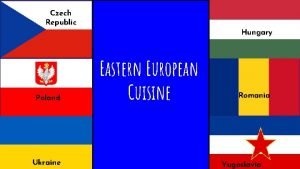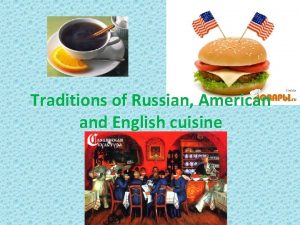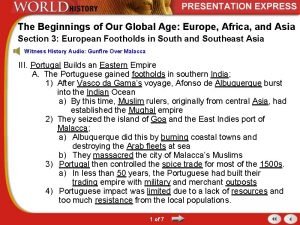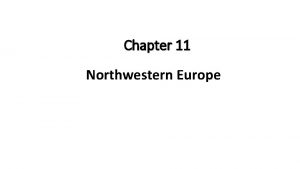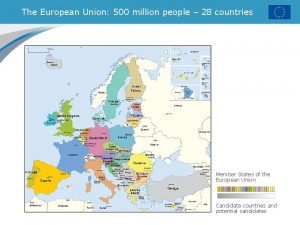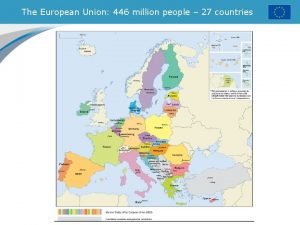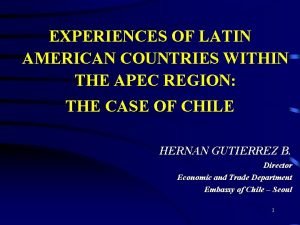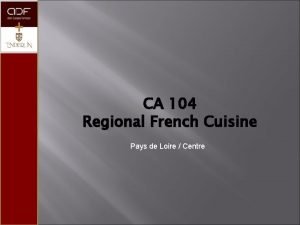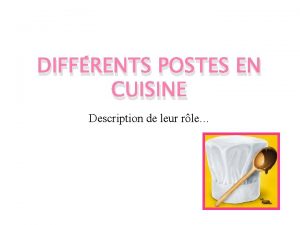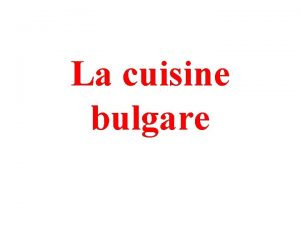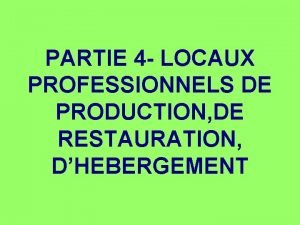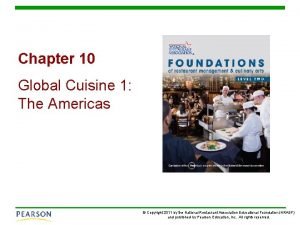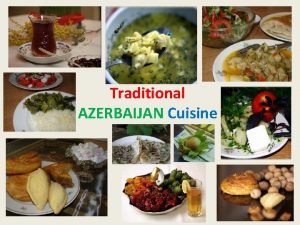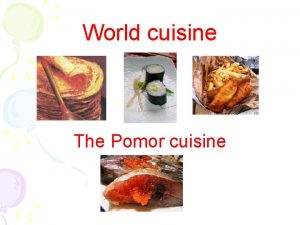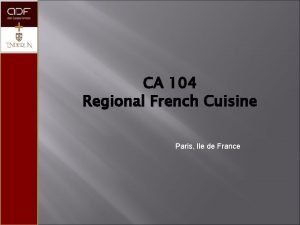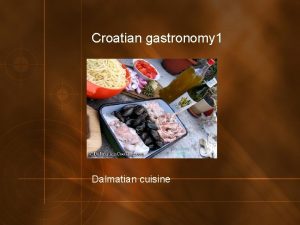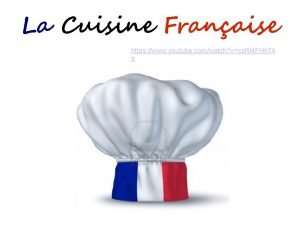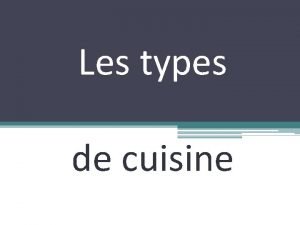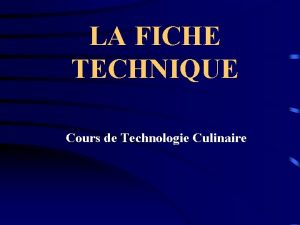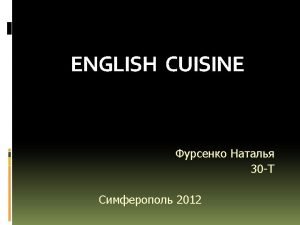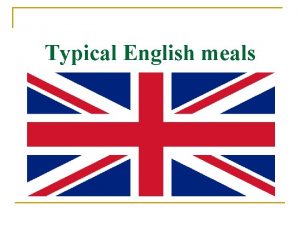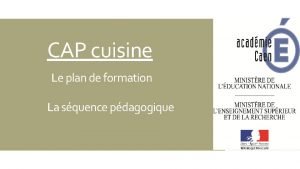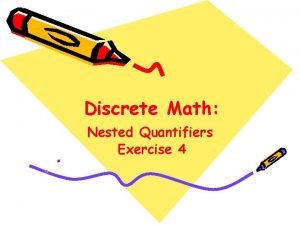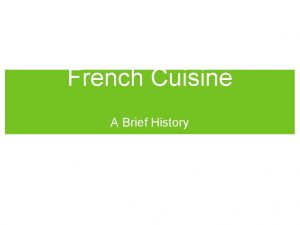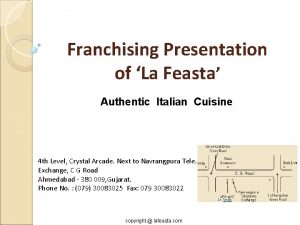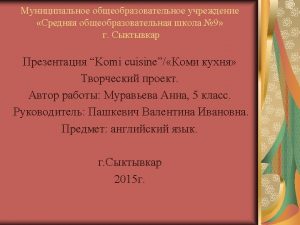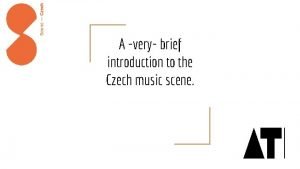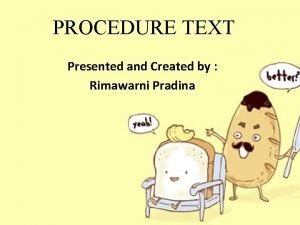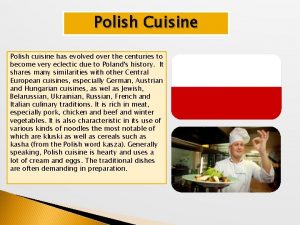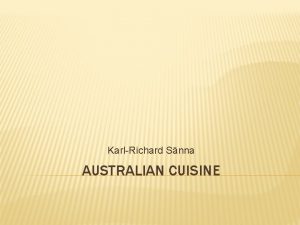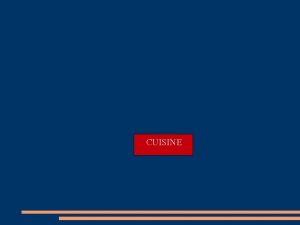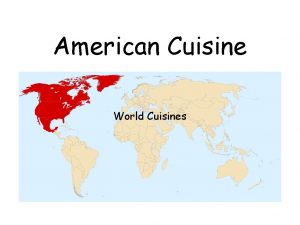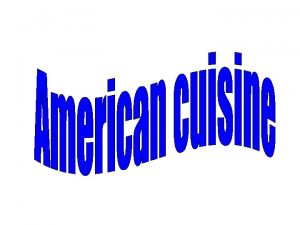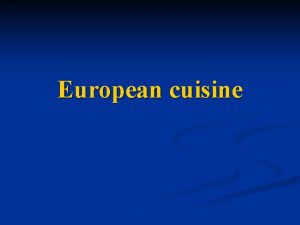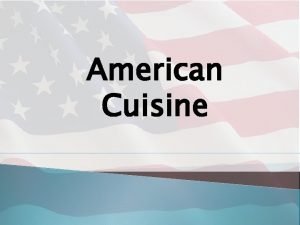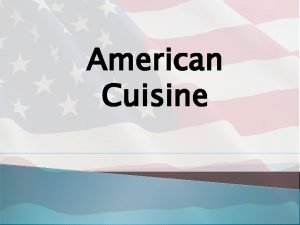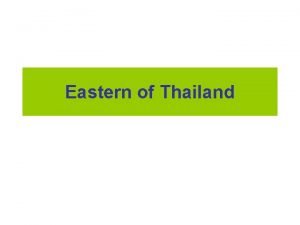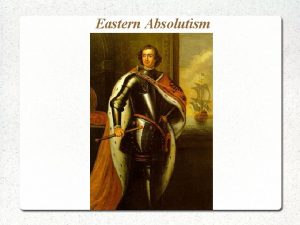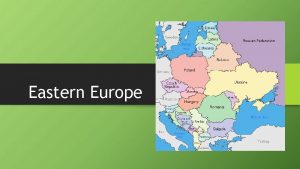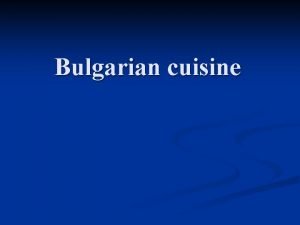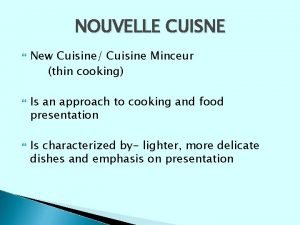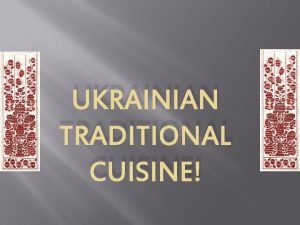POLISH AMERICAN CUISINE Other Eastern European Countries Presented


























































- Slides: 58

POLISH AMERICAN CUISINE & Other Eastern European Countries Presented by Nicci Brown, Leah Cerwinske, Molly Deprenger, Kelly Kester, & Bryana Piazza

Eastern Europe

Iron Curtain

“East Central” Europe

Slavic Nations • Slav: Most ethnically and linguistically diverse group of Europeans • Eastern and southeastern Europe • East Slavs: Russians, Ukrainians, Belarusians • West Slavs: Poles, Czechs, Sorbs • Roman Catholic Church • South Slavs: Serbians, Croatians, Bosnians, Slovenes, Macedonians, Montenegrins, Hungarians, Bulgarians

Polish in America • According to the 2012 American Community Survey from the United States Census Bureau, approximately 9, 500, 696 Polish individuals are currently living in the United States • According to Homeland Security’s “Yearbook of Immigration Statistics, ” from 2003 -2012, 105, 507 nativeborn Poles obtained legal permanent residence in the United States • Outside of Poland, Chicago is home to the largest community of Polish individuals in the world • Chicago’s Polish community often referred to as Polonia

Polish in Chicago: Immigration • Three distinct waves of immigration from Poland to Chicago: • 1) 1850 s-1920 s: Due to economic changes in Poland, this was primarily a “peasant” migration, also known as the “Great Migration” • Also known as “Za Chlemeb” (For Bread) • 2 million Poles left Eastern Europe • Moved to the Northeast and Midwest to work as industrial laborers • By 1930, the Polish community replaced Germans as the largest ethnic group in Chicago • 2) World War II: Due to Nazi takeover in Poland • 3) 1980 s: Known as the “Solidarity” immigration as a result of martial law and the struggle to bring democracy to Poland

Polish in Chicago: Immigration

World War II • During WWII, Germany invaded Poland killed nearly three million Jewish citizens • About two million Polish Catholic civilians were killed • 250, 000 emigrated to the U. S. during WWII • 250, 000 Poles emigrated to the U. S. following WWII

Communist Poland • Following WWII, Joseph Stalin and the Soviet Union controlled Poland other Eastern European nations • Communist control • Stalin and the government tightly controlled all aspects of life • Between 1950 and the late 1980 s, over 185, 000 Poles emigrated to the U. S.

Polish in Chicago • When the Polish immigrated to Chicago, many moved close to where work was. The largest initial area of settlement was near factories on the northwest side and was known as the “Polish Triangle” or “Polish Downtown” • Between Ashland Avenue, Division Street, and Milwaukee Avenue • Expanded into what is now known as Wicker Park, Bucktown, and Logan Square • Currently, not many Poles still live in this area, but the Polish Museum of America is still there on Milwaukee Ave.

Old Polish Triangle

Polish in Chicago • Polish community moved further northwest to the Avondale neighborhood, which is now also mixed with the Hispanic Community • Continued moving even further northwest: Irving Park, Portage Park, Jefferson Park, and Norwood Park are where a large number of Polish Americans reside today • In 1990, 65% of all Polish Americans lived in the suburbs • Niles • Park Ridge • Palatine • Northbrook • Lansing

Where to go? • Laramie Bakery and Deli • 3012 N. Laramie Avenue • Eastern European foods • Paczki, borscht, sausages, cheeses • Harczak’s Authentic Ethnic Sausages • 7035 W. Higgins Avenue • 11 different varieties • Kasia’s Deli • 2101 W. Chicago Avenue • Entrees, soups, salads, cold cuts, cheeses, kolachzis, sides • Red Apple Buffet • 3121 and 6474 N. Milwaukee Avenue (2 locations) • “Polish Home Cooking” - Potato pancakes, stuffed cabbage, Polish sausage

Polish in Chicago

American Polonia • Established immigrant communities in the United States • Largest Polonia community is in Chicago • Polish American Organizations in Chicago • Polish Museum of America • Polish American Association • Polish National Alliance • Polish Highlander’s Alliance of North America

Polish in Chicago • Since 1979, the Chicago Polish community has celebrated Polish food and traditions every Labor Day weekend at the Taste of Polonia in Jefferson Park in Chicago. • While this annual event features Polish speakers, bands, and dancing, the main event involves the food.

Polish in Chicago: Demographics

Polish in Chicago: Demographics

European Food Information Council (EUFIC) Poland Czech Republic Slovenia Croatia Bulgaria Estonia Romania Albania

Traditional Diet and Eating Patterns • Polish food is rich, substantial and relatively high in fat, including saturated fat, and salt. • Typical meals contain a lot of meat or sausages. • The vegetables typically used are cabbage, beetroot, cucumber, carrots, celery, parsley, dill, mushrooms, and potatoes. • Cream and sour cream are common ingredients in soups and sauces, or are added as a topping.

Traditional Diet and Eating Patterns • Red meat, poultry, and sausages are most commonly fried in a generous amount of oil before consumption • Vegetables are often fried after being boiled. • According to a 2009 study from the London Social Marketing Unit (LSMU), traditional Polish foods are “relatively healthy and balanced on the surface. ” • Meals seem healthy based on the different foods and fresh vegetables consumed • The unhealthy food practices identified include: • High levels of fat consumption (fatty hams, smoked meats and sausages, cream, deep frying) • Regular consumption of high-salt condiments

Vegetables • In 1518, an Italian princess married a Polish King, bringing her cooks and gardeners to Poland • Polish food already had many vegetables but she introduced so many new ones that the Polish word for vegetable “wloszczyzna” means “things from Italy”

Traditional Polish Foods • Pierogi • Kapusta • Braised sauerkraut or cabbage, bacon, mushrooms, onion, garlic, and butter • Seasoned with salt, pepper and sometimes bay leaf, sugar, paprika and apples • Golabki • lightly soft boiled cabbage leaves wrapped around minced pork or beef, chopped onions, rice or barley • Baked in a dish in a tomato sauce

Traditional Polish Foods • Bigos • Part of Polish, Lithuanian, Belarusian, and Ukrainian cuisine • “Hunter’s stew” • Typical ingredients include white cabbage, sauerkraut, various cuts of meat and sausages, pureed tomatoes, honey, mushrooms • Meats may include: • Pork, ham, sausage, veal, beef, venison, rabbit, or other game • Seasoned with pepper, caraway, juniper berries, bay leaf, marjoram, pimenta, dried or smoked plums, etc…

Traditional Polish Foods • Sausages • Kielbasa • “Polish sausage” • Smoked • Staple of Polish cuisine • Kiszka • “Blood sausage” • Common in Eastern Europe • Meat, pig’s blood, buckwheat/barley, pig intestines used as casing • Kabanosi • Long and thin • Dry sausage made of pork

Traditional Polish Foods • Soups • Flackzki • Tripe soup: thin strips of beef tripe • Bay leaf, parsley, carrot, beef broth, salt, pepper, nutmeg, paprika, marjoram • Czernina • Duck’s blood soup: duck, hen, rabbit, or pig blood; poultry broth • Polish, Lithuanian • Sweet & sour taste due to vinegar and sugar • Burakowa Zupa • Polish beet soup

Traditional Polish Foods • Pączki: typical Polish dessert • Deep fried dough filled with a sweet filling • Pączki Day, also referred to as Fat Thursday (the last Thursday before Ash Wednesday) was traditionally celebrated to use up all of one’s lard, sugar, eggs and fruit before Lent • Today it is more commonly celebrated on Fat Tuesday • Polish individuals in Chicago celebrate on both days, due to the large Polish community

“Typical Day” in Poland Breakfast (8 -10 am) Toast with marmalade/jam with coffee/tea Lunch (3 -4 pm) Pierogis, Kielbasa sausage, Soup (i. e. Flackzi) Dinner (7 -8 pm) Golabki Snacking is not common!

Catholicism • Great majority of Polish Americans are Catholic • 1/5 of all Catholics in the U. S. are Polish American • Polish Americans have married outside of the church more than American Catholics of other descents

Holidays • Observe Catholic holidays of Christmas and Easter • Christmas Eve celebrate wigilia • Wigilia is a meal with meatless dishes and oplatek

Swienconka • Food baskets brought to church for a blessing on the day before Easter Sunday • Foods have symbolic meanings • • Eggs stand for strength of family and new life Decorated eggs (Pisanki) for Easter

Pulaski Day • National day of remembrance of Polish culture • Parades in large cities in March

Health Beliefs • Faith healers common in Poland • Many Polish Americans very religious and believe wearing religious medals will help prevent illness • Other beliefs to maintain health include avoiding sick people, eating a healthy diet, keeping warm, exercising, and avoiding gossip

Therapeutic Food Use • Some Polish Americans may believe sauerkraut, tea, and soda water are good for colic • Chamomile tea used for cramps • Raspberry tea and wine help with colds • Cooked garlic for high blood pressure • Warm milk, tea, or lemonade for coughs • Tea with honey and spirits to sweat out illness

Food Safety Concerns • Sausage is a staple in Polish Americans’ diets • Important to make sure sausage has “safe food handling” label on packages • Use fresh sausage within two days of purchase • Ensure sausage has been cooked to 160° F using cooking thermometer • Keep cooked sausage out of the danger zone • More species testing on imported beef from Poland occurring

Counseling Concerns • Language barrier • RUMC currently does not have Polish interpreters • Use Interpre. Talk • Cultural differences • Very formal • Extend a handshake, refer to client as Mr. or Ms. • If unfamiliar with the foods that the client mentions, ask them to describe the ingredients and style of preparation

Polish-Speaking Chicagoans: 2000

Counseling Concerns

Prevalence of Chronic Disease • Polish Americans considered white/Caucasian in most U. S. epidemiological studies • Generally lower incidences of chronic diseases such as cardiovascular disease and diabetes compared to Hispanics, African Americans, and Native Americans • However, some Polish-American dietary habits may put them at risk for chronic health complications • HAPIEE Study (Health, Alcohol, and Psychosocial Factors in Eastern Europe): 2009 study by Boylan et al. examined the dietary intake of three random samples of men and women aged 45 -69 years old from Poland, Russia, and the Czech Republic • Used a Healthy Diet Indicator (HDI) with scores ranging from 0 -7 (7 is highest) with a score of 1. 0 +/- 0. 7 among Polish men and women

HAPIEE Study

HAPIEE Study

HAPIEE Study

Diet Restrictions: Diabetic • Sugary Sweets • Not always a part of daily life, but important to educate • Pierogis • Common in a traditional Polish diet • Traditionally contain potatoes wrapped in wheat dough • Educate on starches and impact on blood sugar • Inconsistent intake • Long periods of time in between meals • Encourage a small mid-day snack for carbohydrate consistency, prevent blood sugar spikes and lows

Diabetes Friendly Eating Plan • Breakfast (8 -10 am): Toast with marmalade/jam with coffee/tea (caution with excess sugar) • Mid-day snack: • Lunch (3 -4 pm): Pierogis, Kielbasa sausage, Soup (i. e. Flackzi) • Monitor amount of pierogis consumed for appropriate carbohydrate exchanges • Dinner (7 -8 pm): Golabki

Diet Restrictions: Heart Healthy • Sodium • Typical recommendation: <2300 mg/day • Fat • 25 -35% kcal Many traditional Polish foods are full of sodium and saturated fat: Sausages/meats, soups, pierogis, etc.

Heart Healthy Eating Plan • Breakfast (8 -10 am): Toast with marmalade/jam with coffee/tea • Lunch (3 -4 pm): Pierogis, Low fat/low sodium Kielbasa sausage (or a smaller portion paired with a lower fat meat), low sodium Soup (i. e. Flackzi) • Dinner (7 -8 pm): Golabki • Dessert *Avoid salting foods and adding extra fats (i. e. butter)

Diet Restrictions: Renal • Sodium • Sausages/meats, soups, pierogis, etc • Phosphorus • Traditional Polish foods may be lower in sodium and phosphorus • Americanized Polish sausages and other foods may be more processed here in the US which means that the phosphorus content will increase

Kidney Friendly Eating Plan • Breakfast (8 -10 am): Toast with marmalade/jam with coffee/tea • Lunch (3 -4 pm): Pierogis, low sodium Kielbasa sausage, low sodium Soup (i. e. Flackzi) • Dinner (7 -8 pm): low sodium Golabki • Dessert *Opt for more natural, less processed meats for less sodium and phosphorus

Pierogi • Pierogi are a type of dumpling that originated from Central or Eastern Europe • Poles, Russians, Ukranians, Slovaks, and Czechs claim to have invented pierogi • Fillings include meat, sauerkraut, potato, cheese, and a variety of fruit • Can be served with soup, as a starter sprinkled with fried onion, as a main course with sour cream and applesauce, or even as a dessert www. polishharvest. com

Potato Pierogi Ingredients Traditional Pierogi • 3. 5 cups all purpose flour • 5 large potatoes • 4 green onions • 2 eggs • 2 tablespoons butter Modified Pierogi • 2 cups whole wheat flour • 1. 5 cups all purpose flour • 2 medium potatoes • 2 cups cauliflower • 4 green onion • 2 eggs • 1 teaspoon salt • 2 tablespoons butter • ¼ teaspoon pepper • 1 teaspoon salt • 1 yellow onion • 1 stick of butter (8 tablespoons) • ¼ teaspoon pepper • 1 yellow onion • 1 cup light sour cream

Potato Pierogis Nutrition Facts (3) Traditional Recipe Modified Recipe • 581 Calories • 369 Calories • 12 g protein • 84 g carbohydrate • 61 g carbohydrate • 5 g fiber • 7 g fiber • 23 g fat • 9 g fat • 11 g saturated fat • 504 mg sodium • 388 mg sodium

Step 1: Dough • Using a stand mixer, combine • flour, eggs, water, salt • Knead dough for 3 minutes • Gradually add the rest of the flour to make a stiff dough • Shape dough into a ball • Cover and rest for 10 minutes • Roll dough out on a large, well-floured surface into a big rectangle and cut into 3 -inch circles Photo from www. easterneuropeanfood. com

Step 2: Filling • Put potatoes and/or cauliflower in boiling water and cook until soft • Drain and mash potatoes and/or cauliflower with butter • Stir in minced green onions, salt, and pepper • Put 1 tablespoon of filling into each circle Photo from www. easterneuropeanfood. com

Step 3: Seal Pierogis and Cook • Fold the dough over to form half-moon shapes • Seal by crimping the edges with your fingers or a fork • Drop pierogis into boiling water one at a time • Boil for 5 minutes, stirring occasionally • Drain pierogis Photo from www. easterneuropeanfood. com

Step 4: Brown Pierogi • In a small sauce pan with butter, brown yellow onion and pierogi Photo from www. easterneuropeanfood. com

Step 5: Serve! • Serve with applesauce or sour cream Photo from www. easterneuropeanfood. com

References • "Academy of Nutrition and Dietetics. “ (2013, May. Academy of Nutrition and Dietetics. • • • Home. Food. Safety. org. Anderson, D. (2007). Polish Americans. Milwaukee, WI: World Almanac Library. Print. Boylan, S. , Welch, A. , Pikhart, H. , Malyutina, S. , Pajak, A. , Kubinova, R. , Bragina, O. , Simonova, G. , Stepaniak, U. , Gilis-Januszewska, A. , Milla, L. , Peasey, A. , Marmot, M. , Bobak, M. (2009). Dietary Habits in Three Central and Eastern European Countries: The HAPIEE Study. BMC Public Health, 9: 439. Central Intelligence Agency. (1995). Ethnic Groups in Eastern Europe. University of Texas Library. http: //www. lib. utexas. edu/maps/europe/eeurope_ethnic_95. jpg. Civitello, L. (2004). Cuisine and Culture: A History of Food & People. Hoboken, NJ: Wiley. Print. Flynn, D. (2013, April 4). "Food Safety News. " Food Safety News. N. P. Homeland Security. (2013, November 4). Yearbook of Immigration Statistics: 2012. Retrieved from http: //www. dhs. gov/yearbook-immigration-statistics-2012 -legal-permanent-residents. Iron Curtain Trail. (2013, November 28). http: //www. ironcurtaintrail. eu/en/publikationen/broschuere/index. html Kittler, P. G. & Sucher, K. (2004). Food and Culture. Belmont, CA: Thomson/Wadsworth. Print. Pacyga, D. A. (2005). “Poles. ” Encyclopedia of Chicago. http: //www. encyclopedia. chicagohistory. org/pages/982. html. • “Slavs. ” Encyclopedia Brittanica. http: //www. britannica. com/EBchecked/topic/548156/Slav. 2013. • Smith, Andrew F. The Oxford Companion to American Food and Drink. New York: Oxford UP, 2007. Print. • Studenkov, I. (2009, July 15). “Ethnic Neighborhoods 101: Where are Chicago’s Polish Neighborhoods? ” http: //www. examiner. com/article/ethnic-neighborhoods-101 -where-are-chicago-s-polish-neighborhoods. Thaker, A. & Barton, A. (2012). Multicultural Handbook of Food, Nutrition and Dietetics. Chichester, West Sussex, UK: Wiley-Blackwell. Print. • The Polish American Association. (2004, June). The Polish Community in Metro Chicago: A Census
 Is poland considered eastern europe
Is poland considered eastern europe Reverse polish notation adalah
Reverse polish notation adalah Infix to polish notation
Infix to polish notation Federal republic
Federal republic American cuisine
American cuisine European footholds in the eastern hemisphere
European footholds in the eastern hemisphere The first global age
The first global age What is considered northwestern europe
What is considered northwestern europe European union 28 countries
European union 28 countries European union 28 countries
European union 28 countries In what country would you find a pinata on christmas
In what country would you find a pinata on christmas How might specialization encourage trade
How might specialization encourage trade What are the experiences of latin american countries
What are the experiences of latin american countries Structuralism literature
Structuralism literature What is american structuralism
What is american structuralism European and american structuralism
European and american structuralism Franz boas quotes
Franz boas quotes Loire valley cuisine
Loire valley cuisine Le communard en cuisine
Le communard en cuisine Carnet personnel de techniques professionnelles cap cuisine
Carnet personnel de techniques professionnelles cap cuisine China cuisine
China cuisine Eating habits synonym
Eating habits synonym Ppt on odisha download
Ppt on odisha download Cuisine bulgare
Cuisine bulgare Circuit propre sale cuisine
Circuit propre sale cuisine English cuisine
English cuisine Chapter 10 global cuisine 1 the americas
Chapter 10 global cuisine 1 the americas Azerbaijan cuisine
Azerbaijan cuisine Words that rhyme with cuisine
Words that rhyme with cuisine Ile de france cuisine
Ile de france cuisine Dalmatian cuisine
Dalmatian cuisine Youtube cuisine française
Youtube cuisine française Les types de cuisine
Les types de cuisine Pppst com
Pppst com Pays de la cuisine lune
Pays de la cuisine lune Fiche technique d'un cours
Fiche technique d'un cours English cuisine encompasses
English cuisine encompasses English cuisine
English cuisine Referentiel cap cuisine
Referentiel cap cuisine Lht blois
Lht blois Let t(x y) mean that students like cuisine y
Let t(x y) mean that students like cuisine y Brief history of french cuisine
Brief history of french cuisine Lafeasta
Lafeasta Komi cuisine
Komi cuisine Czech cuisine of perversions
Czech cuisine of perversions Brigade de cuisine
Brigade de cuisine Who
Who Chinese cuisine logo
Chinese cuisine logo Self initiated other repair
Self initiated other repair Professionally presented
Professionally presented How is mr hyde presented as a frightening outsider
How is mr hyde presented as a frightening outsider Proudly presented by
Proudly presented by Presenter title
Presenter title How is the text presented
How is the text presented Truck and plant assets
Truck and plant assets As presented below
As presented below Young and dyslexic benjamin zephaniah
Young and dyslexic benjamin zephaniah Name of the presenter
Name of the presenter Cause/effect text structure
Cause/effect text structure
